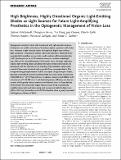Files in this item
High brightness, highly directional organic light-emitting diodes as light sources for future light-amplifying prosthetics in the optogenetic management of vision loss
Item metadata
| dc.contributor.author | Hillebrandt, Sabina | |
| dc.contributor.author | Keum, Changmin | |
| dc.contributor.author | Deng, Yali | |
| dc.contributor.author | Chavas, Joël | |
| dc.contributor.author | Galle, Charlie | |
| dc.contributor.author | Hardin, Thomas | |
| dc.contributor.author | Galluppi, Francesco | |
| dc.contributor.author | Gather, Malte Christian | |
| dc.date.accessioned | 2022-08-29T15:30:11Z | |
| dc.date.available | 2022-08-29T15:30:11Z | |
| dc.date.issued | 2023-07-04 | |
| dc.identifier | 280796969 | |
| dc.identifier | 0305170e-d91a-4ec4-aee2-c9ce2f967d8d | |
| dc.identifier | 85136865081 | |
| dc.identifier | 000846682000001 | |
| dc.identifier.citation | Hillebrandt , S , Keum , C , Deng , Y , Chavas , J , Galle , C , Hardin , T , Galluppi , F & Gather , M C 2023 , ' High brightness, highly directional organic light-emitting diodes as light sources for future light-amplifying prosthetics in the optogenetic management of vision loss ' , Advanced Optical Materials , vol. 11 , no. 13 , 2200877 . https://doi.org/10.1002/adom.202200877 | en |
| dc.identifier.issn | 2195-1071 | |
| dc.identifier.other | ORCID: /0000-0002-4857-5562/work/118411920 | |
| dc.identifier.uri | https://hdl.handle.net/10023/25908 | |
| dc.description | Funding: Engineering and Physical Sciences Research Council (Grant Number(s): EP/R010595/1). National Science Foundation (Grant Number(s): 1706207). Defense Sciences Office, DARPA (Grant Number(s): N66001-17-C-4012). Leverhulme Trust (Grant Number(s): RPG-2017-231). Alexander von Humboldt-Stiftung (Grant Number(s): Humboldt Professur). National Research Foundation of Korea (GrantNumber(s): 2017R1A6A3A03012331). China Sponsorship Council. | en |
| dc.description.abstract | Optogenetic control of retinal cells transduced with light-sensitive channelrhodopsins can enable restoration of visual perception in patients with vision loss. However, a light intensity orders of magnitude higher than ambient light conditions is required to achieve robust cell activation. Relatively bulky wearable light amplifiers are currently used to deliver sufficient photon flux (>1016 photons/cm2/s in a ±10° emission cone) at a suitable wavelength (e.g., 600 nm for channelrhodopsin ChrimsonR). Here, ultrahigh brightness organic light-emitting diodes (OLEDs) with highly directional emission are developed, with the ultimate aim of providing high-resolution optogenetic control of thousands of retinal cells in parallel from a compact device. The orange-emitting phosphorescent OLEDs use doped charge transport layers, generate narrowband emission peaking at 600 nm, and achieve a luminance of 684 000 cd m–2 at 15 V forward bias. In addition, tandem-stack OLEDs with a luminance of 1 152 000 cd m–2 and doubled quantum efficiency are demonstrated, which greatly reduces electrical and thermal stress in these devices. At the photon flux required to trigger robust neuron firing in genetically modified retinal cells and when using heat sinking and realistic duty cycles (20% at 12.5 Hz), the tandem-stack OLEDs therefore show a greatly improved half-brightness lifetime of 800 h. | |
| dc.format.extent | 9 | |
| dc.format.extent | 1902770 | |
| dc.language.iso | eng | |
| dc.relation.ispartof | Advanced Optical Materials | en |
| dc.subject | Channelrhodopsins | en |
| dc.subject | Neurophotonics | en |
| dc.subject | Organic electronics | en |
| dc.subject | Photostimulation | en |
| dc.subject | Retinitis pigmentosa | en |
| dc.subject | QC Physics | en |
| dc.subject | DAS | en |
| dc.subject | MCC | en |
| dc.subject.lcc | QC | en |
| dc.title | High brightness, highly directional organic light-emitting diodes as light sources for future light-amplifying prosthetics in the optogenetic management of vision loss | en |
| dc.type | Journal article | en |
| dc.contributor.institution | University of St Andrews. School of Physics and Astronomy | en |
| dc.contributor.institution | University of St Andrews. Sir James Mackenzie Institute for Early Diagnosis | en |
| dc.contributor.institution | University of St Andrews. Centre for Biophotonics | en |
| dc.contributor.institution | University of St Andrews. Institute of Behavioural and Neural Sciences | en |
| dc.contributor.institution | University of St Andrews. Biomedical Sciences Research Complex | en |
| dc.identifier.doi | https://doi.org/10.1002/adom.202200877 | |
| dc.description.status | Peer reviewed | en |
This item appears in the following Collection(s)
Items in the St Andrews Research Repository are protected by copyright, with all rights reserved, unless otherwise indicated.

